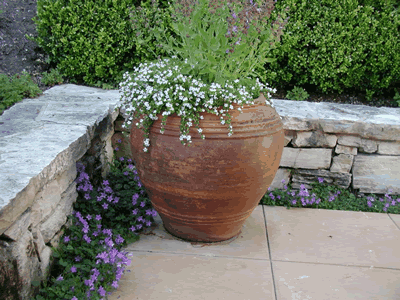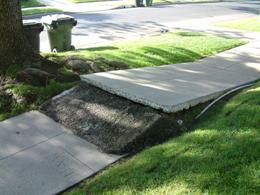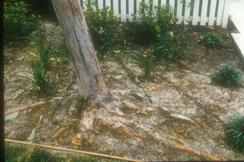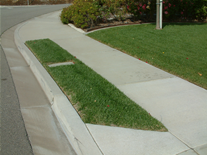- TABLE OF CONTENTS
- DESIGN
- Introduction to Design
- Active Family
- Empty Nesters
- Young Professionals
- Questionnaire
- Principles of Design
- Design Concepts
- Working With Professionals
- Drainage
- Soil
- Climate/Weather
- Safety
- Landscape & Irrigation Plans
- Landscape Design
- Installing the Garden
- Hydrozoning
- Public and Demonstration Gardens
- Xeriscape
- Garden Care
- Composting
- Lawn
- Maintaining Your Garden
- Plant Water Needs
- Mulch
- Pest Management
- Growing a Healthy Garden
- Reading a Pesticide Label
- Pruning Landscape Plants
- Planting Instructions
- IRRIGATION
- Irrigation 101
- Types of Irrigation Systems
- Upgrading Existing System
- Choosing an Irrigation Control System
- Irrigation, Maintenance and Troubleshooting
- Eliminating Run-off and Overspray
- Acknowledgments
Landscape Design
Now it’s time to choose the function of the plants according to the purpose of your garden. Plants have many functions. They are used to shade buildings and pavements, modify temperature, control erosion, soften architectural lines, protect from wind, screen views, and enhance living areas. Choosing plant function and then selecting individual plants can be the most exciting and rewarding part of designing a garden. Plants are the finishing touches in a garden. Once you have established your garden design, go to the Plant List (from the Main Menu) to choose the actual plants.

Planting plan, as plants are selected, draw or sketch their location on a plan.
Below are design tips on creating a basic planting plan:
• Include plants that are resistant to pests and ones that attract beneficial bugs and birds that eat the pests. You might consider Ceanothus, Lavenders, Sages, Tagetes, Echinacea, Encelia, and Yarrow will attract beneficial insects like lacewings, lady beetles, mealy bug destroyers.
• Begin by placing trees, large shrubs, and foundation plantings in key positions to form the overall scheme. These large, woody plants are needed in the garden. Without them the garden appears flat and uninteresting particularly during the winter season as the smaller deciduous shrubs and most perennials may be bare and dormant.
• Foundation planting (shrubs located at the base of your home) is also a vital part of the plan. Foundation plants have historically been used to block the view of raised house foundations and to slow cold air movement under the house. This type of planting highlights the main entrance, complements the architectural style of the home, breaks long continuous lines, and blends the home into the surroundings. Be careful to choose plants that will not be too high and/or wide at maturity.
• A general rule of thumb is that the plant height should not exceed two-thirds of the height of the wall at the corner of the house.
• Planting too close to the house is a common error. Whatever the radius of the plant will be at maturity would be the same distance the plant should be placed from the foundation. If the tree you are planting will have branches reaching a distance of 10 feet from the trunk, then that tree needs to be planted at least 10 feet away from the foundation of the house. This will allow room for the plant to grow properly, allow adequate air circulation near the house, and possibly prevent damage to the foundation as the tree matures. Check with your energy provider for types of trees to plant under power lines.
• Once trees, large shrubs, and foundation plantings have been chosen, add plants that will be used for screening or partitions, such as hedges, vines, or espaliers. Plants provide an inexpensive, interesting, and colorful screen. Living plant screens can be combinations of raised landform, ground covers, small shrubs, large shrubs, and trees. This combined planting is especially suited for noise abatement where the lot adjoins a busy street.
• Next, it is time to add the smaller plants such as low-growing shrubs, vines, and perennials. Arrange these plant types in groups of like species to create a mass effect. Space like plants at a distance slightly less than mature width. Space different plant types at mature width plus another foot or more; this will create a clean looking design, reduce the need for pruning, and improve health by providing good air circulation. Keep in mind that massed plants can be susceptible to insect infestation such as mites and scales (usually due to poor air circulation).
• To tie the planting plan together, add the ground covers (for example, low-growing manzanita for sunny areas and Ajuga for shade). Choose ground covers with low-maintenance requirements. If there is leaf drop from deciduous trees and shrubs onto the ground cover, choose ground covers tolerant of raking and blowing. However, be aware that it is unnecessary to rake leaves from ground covers since the leaves will disintegrate and drop to the soil surface where they will provide a moist and rich compost for the plants.
• Less is more in planting design. Complex designs usually require more maintenance. Simplicity can be achieved by avoiding unnecessary detail. For example, limit the number of plant species and create well-defined planted areas by not scattering plants throughout open areas.
• Plant shrubs, as well as trees, according to their mature width and height. This will save you years of added maintenance costs and labor.
 |
• Avoid planting trees in lawns. The water needs of a healthy lawn may adversely affect the health and longevity of the tree.
• Consider how much lawn you would like or need. Place lawn where it will be enjoyed or forego lawn altogether (it is the highest water-consuming plant in a garden), and consider lawn alternatives, such as ground covers, decks, drought tolerant plants, terraces, and/or patios. Be sure the lawn corners are no less than 90 degrees. It is difficult to irrigate a narrow area of turf without flooding. Turf or groundcover areas that are irrigated with sprinklers should not be less than 8 feet in any direction.
• Be sure the lawn corners are no less than 90 degrees. Generally, it is difficult to effectively irrigate a narrow area of turf without flooding.
• If you enjoy seasonal color, consider container gardens with lush, luxurious, and low-maintenance ornamentals and grasses.
 |
• A year-round evergreen garden can be achieved with hardy, low-maintenance plants.
• Long, narrow strips of bare ground can be planted with colorful, low-maintenance, water-thrifty perennials.
• Consider an organic garden (also known as a natural or chemical-free garden). Organic gardening considerably lessens the need for chemical fertilizers and pesticides. It creates healthy soil, which in turn, promotes healthy plants less susceptible to disease and insects.
• Keep in mind your utility infrastructure when digging. To find out where your utility lines are call 811, 800-227-2600, or browse to http://www.usanorth.org/
• Look for plants with the same hydrozone designation (water needs). Grouping plants with similar water needs allows you to water your garden precisely.
• Resist the need for instant gratification and avoid making an “instant” garden. This will cause over-crowding of plants. However, if you love to browse garden centers, native plant sales, and farmer’s markets for unusual plants, plan to dedicate an area in your garden for such spur-of-the-moment plant additions.
• Buy healthy, well-rooted plants within your budget, not necessarily the biggest plants.
• Keep in mind that the wrong plant or the wrong planting location is a recipe for an unhealthy, unproductive, unattractive, and costly landscape. Select plant varieties that are not only going to achieve the desired visual effect, but that are going to thrive where they are planted.


The tree at the edge of this photo has There is no soil left to grow other plants
surface roots that are pushing up the due to the surface roots of the tree.
sidewalk.
• To make your planting a success, choose plants well-suited by nature to the particular physical conditions in which they will be expected to grow. For example, a drought tolerant plant should not be planted in a wet, shady area, because the plant will drown.
The Plant List on the Main Menu is a great place to begin selection for your garden.
Parking Strips
If you have a parking strip (the area of land between the sidewalk and curb, also known as a "planting strip") that is adjacent to your property, be sure to consult with your local public works department about planting and maintaining the strip. This area is a public easement and is controlled by the municipality. If there is a tree in the parking strip, it is your responsibility to water and care for it, but it is the city’s responsibility to prune it. Generally you can have the tree pruned by a certified arborist if you acquire a no-fee permit from the city. Planting within the parking strip is usually allowed and not regulated. While many parking strips are planted with turf, there are many better alternatives. Because the parking strip is so narrow, it is a difficult area to irrigate with traditional spray heads. This practice results in a lot of irrigation runoff. It is better suited to a drip irrigation system and water-wise plants.
Please refer to the Garden Gallery section on the Home Page for ideas on how to landscape the parking strip.
 |
Traits to consider when choosing plants for parking strips:
• Water efficient
• Adaptable to different soil types
• Persistent (bulbs, perennials, low shrubs)
• Compact height (under 3 feet)
• Attractive foliage
• Tidy growth (little pruning needed)
• Variety of textures and shapes
• Flower colors to suit your taste
• Varied bloom times